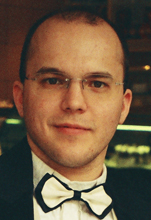 This unusual and, ultimately, compelling new recording of Bach’s transcendental Aria Mit Verschiedenen Verandergungen introduces us yet to another outstanding Hungarian pianist, Sebastyen NyirÖ, who was born in 1979. This may well be the broadest and longest performance of the Goldberg Variations ever. NyirÖ favors taking all the repeats (even those in the Aria da Capo which even the near-fanatical purist Claudio Arrau was even willing to forgo in his early 1940s RCA recording released posthumously on two CDs. Rosalyn Tureck, another famous (or notorious) advocate of repeats and slow tempos, likewise ran over onto two CDs in the Philips Great Pianists of the 20th Century reissue. Simone Dinnerstein, another champion of slow tempos, played all the repeats in her in-concert performance at Weill Recital Hall, but reluctantly condoned omitting a few of them in order to limit her commercial recording (a labor-of-love, later taken over by Telarc) to a single CD. Nyirö’s rendition runs to 85 minutes and fourteen seconds: CD no. 1, with the Aria and Variations 1 through 15 taking 40 minutes and 12 seconds; CD no. 2 beginning with the French Ouverture Variation 16 and ending with the Aria da capo runs 42 minutes; 14 seconds for the work’s conclusion.
This unusual and, ultimately, compelling new recording of Bach’s transcendental Aria Mit Verschiedenen Verandergungen introduces us yet to another outstanding Hungarian pianist, Sebastyen NyirÖ, who was born in 1979. This may well be the broadest and longest performance of the Goldberg Variations ever. NyirÖ favors taking all the repeats (even those in the Aria da Capo which even the near-fanatical purist Claudio Arrau was even willing to forgo in his early 1940s RCA recording released posthumously on two CDs. Rosalyn Tureck, another famous (or notorious) advocate of repeats and slow tempos, likewise ran over onto two CDs in the Philips Great Pianists of the 20th Century reissue. Simone Dinnerstein, another champion of slow tempos, played all the repeats in her in-concert performance at Weill Recital Hall, but reluctantly condoned omitting a few of them in order to limit her commercial recording (a labor-of-love, later taken over by Telarc) to a single CD. Nyirö’s rendition runs to 85 minutes and fourteen seconds: CD no. 1, with the Aria and Variations 1 through 15 taking 40 minutes and 12 seconds; CD no. 2 beginning with the French Ouverture Variation 16 and ending with the Aria da capo runs 42 minutes; 14 seconds for the work’s conclusion.
Quite apart from repeats and deliberation, Nyirö’s ideas via embellishments are extreme and immediately evident. His account of the Aria is so profusely ornamented that this listener was momentarily at a loss for a few seconds to recognize the basic melody amidst the labyrinth of encrustations. One famous pianist, Wilhelm Kempff, made a recording of the Goldberg for D.G. and unconventionally opted to reduce and strip the tema to its bare skeletal bones (banishing even the minimal decorations that Bach’s original included in his notations). NyirÖ, one might say, is the anti-Kempff!
As the recreation unfolds, Nyirö gradually makes us aware of several important qualities: first, his extreme rigor and clarity of contrapuntal texture. In this respect, his interpretation even exceeds this aspect of Glenn Gould’s 1981 second recording (the first—from 1955—couldn’t be more different, with its remarkably fast tempos and the omission of many, if not all, repeats). Also, in similarity with a well known tradition favored by the conductor Otto Klemperer (of linking some variations together in a single mathematical metronomic pulse), Variation 18, for instance, is admittedly brisker than usual, but the next variation follows at exactly the same half speed tempo. The aforementioned rigor is expressed in severely accented (even martellato) rhythms. NyirÖ is remarkably potent in his handling of the French Ouverture Variation No. 16’s first introductory half, although I was admittedly perplexed by his extremely deliberate treatment of the ensuing second half (which I feel is too static, albeit vital and rhythmically steady).
In describing Glenn Gould’s basic style (not only in Bach), I once wrote about his combining “swooning sensuality with ecclesiastic rigor.” Some of this description might likewise apply to Nyirö’s Goldberg, but the rigor is more evident than the sensuality (though I find some of the pianist’s lavish rubatos “swooning” but never “sensual.”) It will, I admit, take numerous rehearings of this recording to accustom me to certain iconoclastic details, but at the moment, only three or four variations made me take umbrage: Variation 25, which Landowska poetically dubbed as “the Black Pearl”, seems to me more akin to a “Schwartze Maria”: rather tediously fragmented and funereal, and lacking requisite flow and lyricism. Variation 28, with its written- out trills (which may sometimes seem to offer a foretaste of the finale of Beethoven’s Waldstein Sonata) is resolutely nailed to the mast. I found Variation 29 aggressively (even assaultively) splashy, and No. 30 could benefit from a touch of requisite levity and humor.
But, ultimately, one is forced to make an attempt to meet Mr.Nyirö on his own terms, pay respect to some technically wonderful pianism, and bow to his deeply motivated, honest experience and his musical thinking. I urge everyone to acknowledge Nyirö’s supreme talent and be tolerant of what may at first seem like off-putting eccentricity.
The recorded sound, incidentally, is vividly realistic.
